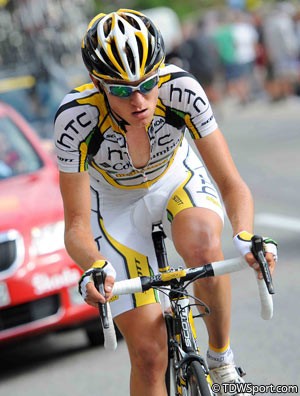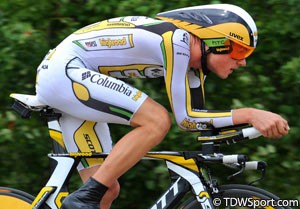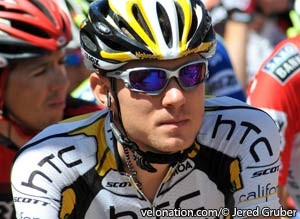Part of the bright future for US cycling on the way to his first Grand Tour
 HTC-Columbia’s young talent Tejay van Garderen stunned his elder peers with an incredible performance in the Critérium du Dauphiné this past June. Although just 22 years of age and in his first year at the ProTour level, he finished a scant two seconds behind Tour de France champion Alberto Contador in the prologue, was fourth in the final time trial and took third overall. The result was completely unexpected, and was due partly to his strong performance on the legendary climb up Alpe d’Huez.
HTC-Columbia’s young talent Tejay van Garderen stunned his elder peers with an incredible performance in the Critérium du Dauphiné this past June. Although just 22 years of age and in his first year at the ProTour level, he finished a scant two seconds behind Tour de France champion Alberto Contador in the prologue, was fourth in the final time trial and took third overall. The result was completely unexpected, and was due partly to his strong performance on the legendary climb up Alpe d’Huez.
He has been lighting up the US cycling scene for more than a decade now, first as a twelve year old national champion, then he did it again at the age of fourteen, and continued his streak of national title successes all the way through his junior career. Van Garderen has most recently taken his experience on the top European Continental team and earned himself a ride on the ProTour’s most winningest squad.
For many back home, the Montana native seems to have come out of nowhere this year to land a spot on a ProTour team, but it was his decision to take a different approach that kept him out of the headlines in his home country. After racing with the national team in 2007, van Garderen headed to the Dutch Rabobank Continental team the following year.
His father Marcel is originally from Holland, so signing with the country’s biggest cycling program could be seen as a homecoming of sorts. He went on to excel in the Rabobank development program during his two-year stint there, and notched up several wins, including the Circuito Montañes (2009) as well as a stage (2008) and second overall (2009) in the Tour de l’Avenir.
We spoke to him just as he was getting ready to leave for Spain to ride the Vuelta a Espana, in what will be his first participation in a Grand Tour. In part one of VeloNation’s two part feature on van Garderen, he tells us about his journey to the ProTour and his experience through the first half of the season with the HTC-Columbia team.
————————-
VeloNation: For being only 22 years old you’ve been around for quite a while, but most of your racing has been in Europe, first in Belgium with the US team and then for Rabobank’s Continental team. How did you end up riding for a Dutch team?
Tejay van Garderen: I rode for the national team both as a junior and for my first year for Under 23, and I think Rabobank was just looking for an American because they wanted to open up some banks in the [United] States. They wanted an American rider for their sponsor, and Noel [Dejonckheere – former U23 Development Program Director] was good friends with the directors on the team [Rabobank], so he just kind of hooked me up with it.
VN: You were progressing well with Rabobank – in your second season there you won the Circuito Montañes and finished second in the Tour de l’Avenir. Were they considering bringing you onto the ProTour squad?
TvG: Yeah, I think they were playing the ‘wait and see’ game with a lot of their riders like me and Theo Bos, Dennis Van Winden, Steven Kruijswijk and Michel Kreder – we all were riding well that year and getting a lot of results and they only had room for two guys on their squad. We’d ask them ‘Hey, do you want me on the team?’, and they’d be like, ‘I don’t know we have to wait, I don’t know we have to wait’, and I had offers from other teams, so I didn’t really feel like waiting around anymore, so I just kind of left. [pauses] I think they might have actually been relieved that I left, because then there was less competition for the two slots.
 VN: HTC-Columbia has a lot of success grooming young talent, so was that a big factor in your decision to sign with them?
VN: HTC-Columbia has a lot of success grooming young talent, so was that a big factor in your decision to sign with them?
TvG: Oh, for sure. You look at some teams and they bring on a young guy and they just disappear and you never hear from them again, but at HTC-Columbia they kind of have the opposite to where you might not have heard of the guy when he was young, and then he just flourishes on the HTC program. Yeah, that was definitely a big factor.
VN: They also spread the wealth and seem to give everyone on the team their opportunity to shine. Their approach to the races has them winning more races with more riders. What do you see that might be different on the team to allow that to happen?
TvG: I think riders are just…when you have a sprinter in the race like Greipel or Cavendish a lot of the younger guys, you know, they have to work on the front. Even though that might not be the best atmosphere to get a result because you’re going to be tired and not able to ride for yourself for maybe the next stage, but it definitely gives you a lot of morale because I think a lot of these races are above first year riders’ heads. Just the fact that they can do work and feel like they’re a part of the race and really contribute, that just gives them a big morale boost. Then when they do get the chance to work for themselves they have the confidence that they can be competitive in these races, and they have the strength because riding the front in these kinds of races is not easy and it gets you strong, for sure.
I think that that has something to do with it, and the fact that they [young riders] get the same treatment as the older more established guys. You get wind tunnel testing, you get to work with the best trainers and you get the same amount of focus as a guy like Michael Rogers would get. That’s something I don’t think you see on very many teams. I think a lot of them favor the older, established rider getting results, and everyone else has to prove themselves first, before they can get that sort of attention. So that’s another one of the things that makes the younger guys really, really flourish.
VN: There hasn’t been much coverage in the US about your development prior to this year – do you think it was just because you were racing across the pond?
TvG: I don’t know, I think it’s because I was racing in Europe. Okay, I won races like Circuito Montañes and the Tour du Haut Anjou, but I don’t blame people for not knowing or hearing of that because before I did the race I had never heard of it either. I just showed up and saw it on my race program and, okay, I’m here to race. When you do a race like the Dauphine or the Tour, yeah everyone knows those races, but I don’t think it’s a big issue that I wasn’t getting huge write-ups for winning the Circuito Montañes. [laughs]
VN: So you rode your first Monument this year with Liège–Bastogne–Liège and you finished. You have been riding 200km events for a while. You must have come into it on a high after finishing second on stages and in the overall at the Tour of Turkey – what was it like for you doing the extra distance at the ProTour level?
TvG: It was brutal! I kept getting these stomach problems at the end and just my whole body hurt…it was just a hard day. It was really hot that day too, and I had kind of a rough travel after Turkey because that was right when the volcano [eruption] happened. I actually had to take a taxi all the way from Rome to Pisa and it cost me quite a bit. [laughs] All the rental cars were booked, the trains were booked, hotels were booked, I couldn’t get a flight in that direction and it was just a nightmare. My only option was to take a cab.
I don’t know, it was definitely cool to do it and cool to be on that parcours, but the distance was definitely a shock the first time doing it…I died in the heat, I bonked, I was having stomach problems and it was kind of a nightmare actually, but yeah I’m glad I did the distance. I think it’s something that maybe a couple of years down the road I could do well at.
VN: Your next race was the Tour of California at home with one of the race’s best fields taking the start. You put in an impressive ride in service of Rogers, who eventually took the overall win. Do you see the experience of riding for the leader’s jersey another step in your progression as a rider?
 TvG: It was cool to race on home soil, but had been racing with those guys all year and even years prior with Rabobank. I was already doing some pro races in the 2.1 rank, so it wasn’t like – oh California was the turning point – but it was definitely cool to work for a winning GC squad and get that experience. I had already been riding the front for Greipel or Cavendish, and I had been doing stuff like that all year, so I wouldn’t say that California was my big confidence booster. I think it was just another race. I think the team was really happy with the work that I did especially with me giving up my wheel for Rogers when he got a flat on stage two.
TvG: It was cool to race on home soil, but had been racing with those guys all year and even years prior with Rabobank. I was already doing some pro races in the 2.1 rank, so it wasn’t like – oh California was the turning point – but it was definitely cool to work for a winning GC squad and get that experience. I had already been riding the front for Greipel or Cavendish, and I had been doing stuff like that all year, so I wouldn’t say that California was my big confidence booster. I think it was just another race. I think the team was really happy with the work that I did especially with me giving up my wheel for Rogers when he got a flat on stage two.
That kind of messed up my own chances for GC, but I think they appreciated the selfless act, so I think what it did for me was it assured the team that I could not only be a strong rider, but I’m also willing to do a lot of work whenever necessary and I think they appreciated that. For my confidence, I already kind of knew I was there.
————————-
In part two of Tejay van Garderen’s interview he talks about his ride in the Critérium du Dauphiné, shares some insight for young riders trying to break into the European cycling scene, and his expectations going into his first Grand Tour.